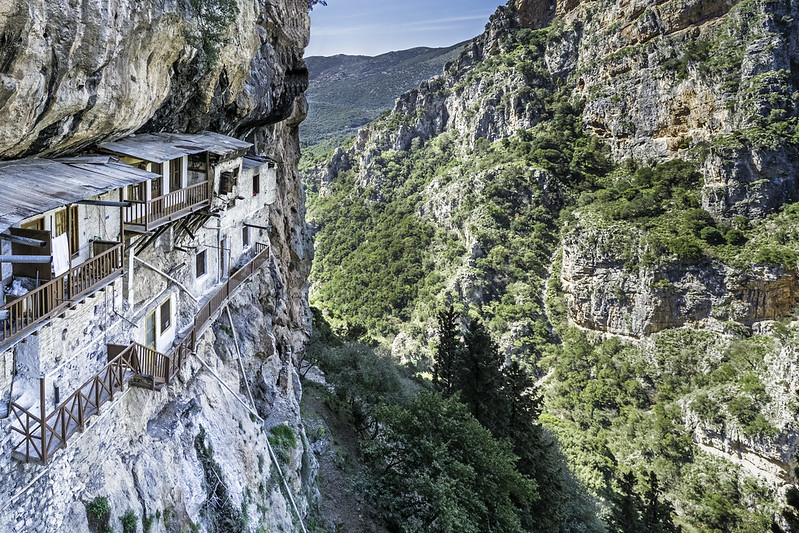
Lousios Gorge has been inhabited for centuries in Greece, mainly by hermits and monks who lived in caves. Two monasteries located near the gorge remain open to visitors: Philosophou and Timiou Prodromou (St. John the Baptist).
The historian Pausanias described Lousios Gorge as the place where Zeus was bathed as an infant; Lousios in Greek means “to bathe.” He claimed it was the coldest river of the known world. It flows through an impressive gorge, with red limestone cliffs, rising to 100 meters (328 feet) above the river. The plant life there in early spring is lush and spectacular.
After leaving the parking lot that leads to the gorge, hikers first come across the Church of St. Andreas. It has frescoes of angels that are similar to those found at the spectacular site of Mystras. The church was built upon the ruins of a large Roman building that itself was constructed on top of an ancient Greek building.
Area of Lousios Gorge in Greece home to many important sites
As a traveler keeps hiking, the 4th century ruins of Gortys appear. This was a healing center with a bath house. The circular construction on the site was a dry sauna.
Philosophou Monastery is widely known across Greece and abroad. During the Ottoman period, it had a famous school where many prominent thinkers were educated.
The monastery is located approximately 4 km (2.4 miles) south of Dimitsana. It was built at the foot of a tall cliff, 200 meters (656 feet) above the bottom of Lousios Gorge.
The location for the monastery was chosen by John Lampardopoulos of Dimitsana, chief secretary to Byzantine Emperor Nicephorus Fokas. Lampardopoulos became a monk at the end of his life. He was a noted philosopher as well.
He founded the monastery under a patriarchal sigillium (jurisdiction) in the year 964. The seal indicating the authorization for the founding survives in the Dimitsana library. Today it is called the Old Philosophou and Secret School.
Many bishops and teachers were educated in this glorious monastery. Historians view it as a spiritual hotbed of Hellenism during the days of Ottoman rule. Seven Patriarchs, including the martyred Patriarch Gregory V and seventy bishops, were educated there.
The School of the Philosophou monastery has a rich collection of books and manuscripts.
Many documents, however, were destroyed during the upheaval of the 1821 Revolution and the monastery’s dissolution in 1834.
Two important 12th century manuscripts, the complete works of M. Kingdom and the Gospel of Vlachomanoli, in which the secret organization developed before the Greek War of Independence called the “Filiki Eteria” swore their oaths, survive in the National Library of Greece in Athens.
At that time, the Venetians ruled the Peloponnese. They were noted for allowing more freedom for the local people to build churches. The “New Philosophou” monastery was founded in 1691, under Abbot Anthimos. The new building is shaped as a cruciform basilica, supported by four domes.
The Dimitsana School
The Dimitsana School was founded in 1764 by the Dimitsana monks Gerasimos Gouna and Agapios Leonardos. In 1816, the New Philosophou monastery united with the Dimitsana School for financial reasons. In 1834, it was closed and the property was sold to the church fund. New Philosophou has resumed an active life as a monastery in the year 2000, however, with 11 monks.
In a highly traveled tourist area, the resumption of the monastery’s religious life shows the historical importance of perpetuating the religious life of an exceptional monastery while remaining open to the public.
Prodromou monastery, dedicated to John the Baptist, is the most visually stunning, however, with its stone building and wooden balconies overhanging the cliffside. Its foundation dates back to 1167. The monastery was tragically dissolved in 1834.
Local legends say that all its relics and records were carted off by 16 mules. The monks rebuilt the monastery’s wealth through hard work, by building mills and keeping livestock. The church is built into the cliffside with 16th century frescoes and balconies.
The old wooden door leading into the monastery is riddled with bullet holes that bear witness to the April 16, 1779, attack by Albanian troops under Ottoman command. At the time, the monastery was full of women and children taking refuge there, but for some unknown reason the attack failed.
Spring is the best time to appreciate the natural beauty and extraordinary monasteries of the Lousios Gorge, against the backdrop of its great historical, religious and architectural treasures.
See all the latest news from Greece and the world at Greekreporter.com. Contact our newsroom to report an update or send your story, photos and videos. Follow GR on Google News and subscribe here to our daily email!



